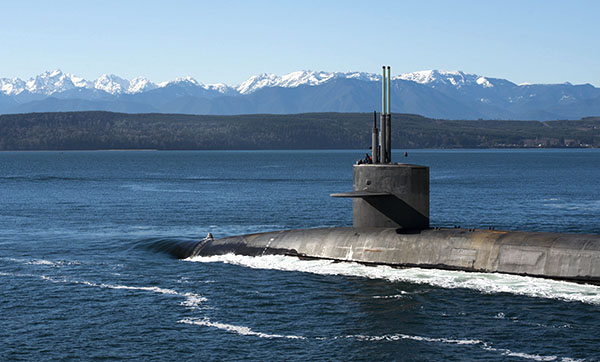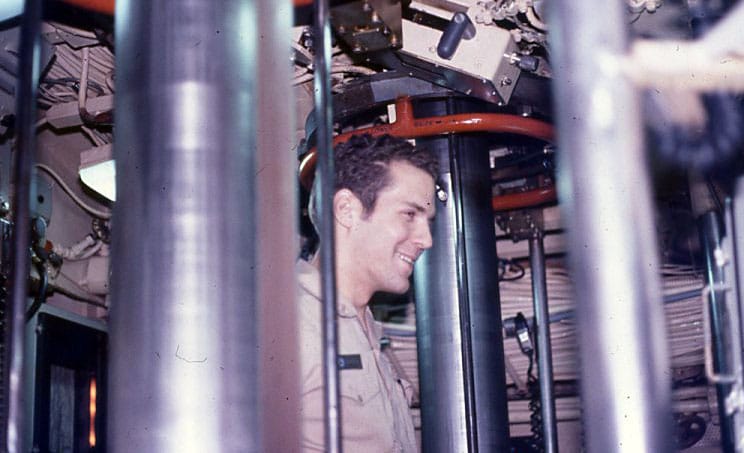[Two days this week talking about STAMPS!! What a party this blog is! ;) But remember when I said it would be a rather great side hustle to take on? Well here’s a story of a guy who went for it, as told by a former member of the U.S. Navy’s submarine force, Doug “Nords” Nordman. But you gotta go way back in the time machine for this one and head to the pre-internet days of 1985! What a world!]
******
Every time the post office raises their prices, I smile as I remember one of my shipmates.
Those of us in the Silent Service are not at liberty to discuss submarine operations, but let’s just say that we weren’t in port to take note of the price hike that went into effect on 17 February 1985. It was a biggie, too — first-class stamps went from 20 cents to 22 cents.
(This was back when inflation had recently been rising at double digits, and even some checking accounts had been paying 10% APY. But I digress.)
Today it’s hard to explain, but back then you lived your life by snail mail. The only people who knew about the Internet were hiding in university computer labs. The World Wide Web wasn’t even a twinkle in Berners-Lee‘s eye, and phone calls were expensive. If I hit an overseas liberty port and wanted to chat up girlfriend v3.0 (who later upgraded to spouse v1.0) then it might cost five. dollars. per. minute.
During those days on my first submarine, one of my shipmates was just a bit different. For purposes of this story, we’ll call him “Ed”. Ed is an extraordinarily smart and cheerful extrovert who loves a good joke, and he’s a natural business magnate. You could always count on him to be reading the Wall Street Journal or ruminating over a Business Week report on some obscure geek tech company like “Micro-Soft”.
Ed was perpetually alert to an opportunity to make a buck, too. For example he was one of the first people I knew who owned his own video camera. Back then they were an expensive indulgence for rich people, but to Ed they were merely a capital expense in an untapped market. Once he obtained the commanding officer’s permission to bring it on board, he was always videotaping crew life in the (unclassified) spaces.
Word was that if you had a blank videotape and a couple bucks, Ed would help you make a video to send to your family or just to document your memories of “the good ol’ days”. I’m pretty sure that video camera paid for itself long before everyone else owned one. Ed certainly earned a lot of goodwill from his efforts.
Back then Ed was fascinated by consumer behavior. When we were packing our seabags for a 90-day underway submarine patrol, Ed’s list was also just a bit different. Most of us were trying to figure out how to squeeze an extra pair of socks or underwear into the storage under our bunk mattress, or maybe even a bag of candy bars. Ed would be bringing on board cartons of cigarettes. If he could, I’m sure that he would have smuggled them down the hatch by the pallet. For the first two months of a 90-day patrol, Ed’s stateroom always smelled like a tobacco barn.
The irony was that Ed didn’t even smoke, and I’m sure his roommates would have appreciated it instead if he’d treated himself to some extra socks or underwear. But Ed, a keen observer of human consumption, had noted the powers of nicotine addiction. If you ran out of cigarettes before you ran out of submarine patrol, you couldn’t just pop up to the surface and run down to the nearest vending machine for a pack. (Back then cigarettes were sold in vending machines – really!)
He knew that cigarettes had an extraordinarily high price-per-volume ratio — far higher than cans of soda or candy bars. However during the last 30 days of the patrol that price would rise exponentially as the nicotine addicts ran out and started jonesing for a fix. You couldn’t just “quit smoking” because back then smokers were everywhere. The stress and the fatigue were bad enough, let alone the withdrawal pains and the second-hand smoke. After 48 hours surrounded by smokers you’d be willing to sell your entire next enlistment for a pack of cigs.
I hasten to add that nobody actually ever caught an officer dealing cigarettes to his shipmates, let alone the crew. Ed was way too discreet for that. Yet somehow at the start of a patrol his seabag was always the bulkiest, and by the end of the patrol his wallet was always the fullest.
Parts of that time are seared into my memory. Back then our submarine did its upkeeps in the very, very, very small town of Holy Loch, Scotland. For that patrol I remember arriving there the day before Christmas. (I’d just enjoyed a couple shamelessly hedonistic weeks vacationing overseas with GF3.0. But that’s another topless sea story.) The next day I nearly starved in the hotel (because none of the Scots staff were sober enough to prepare meals) and I finally found an Indian restaurant that was the only food service in town (they weren’t closing for a Christian holiday).
The rest of our crew arrived two days later and we met the submarine. As you can imagine, after their own 90-day patrol (and missing Christmas) the other crew was eager to turn over the boat. They had just enough time to get the heck back home to be with their spouses & significant others before the New Year’s Eve “fireworks”.
So if we were packing our seabags that December, then we had too many things on our mind to pay attention to postage rate hikes coming in February. I know we didn’t have any spare time during turnover because the other crew was so eager to get home. Upkeep was always 18-hour days with scarce liberty, and at those times only the bars & restaurants would be open.
We were probably getting underway for the 90-day patrol around the end of January. We’d be underwater until the end of April, but nobody wanted to think that far ahead. We were all cramming in a few precious last-minute Christmas memories with our families, and then we were flying to Holy Loch, and then we were busy getting the boat ready to go back to sea and postage rates were the last thing on peoples’ mind.
Except Ed. Ed was hard-wired to think about economics, and this time he did some pre-patrol shopping at the post office as well as the tobacco shop.
Remember, back then snail mail was your most cost-efficient means of communication. Your letter-writing reputation was only as good as the rest of the crew. If you were a married submariner, the entire spouse’s club kept track of the mail count. If your spouse got only one letter during a three-week upkeep, but the other spouses got three letters, then you were in trouble when the boat returned three months later.
Even worse, submarines occasionally had emergencies on patrol requiring a medical evacuation or a humanitarian evacuation. Everybody hated them because they were crises, someone was suffering, and they always happened at a terrible time. Usually the response between “crisis” and “evacuation” was less than 24 hours, and there wasn’t time to do anything but scramble for the rendezvous point.
However a little-known side benefit of MEDEVACs and HUMEVACs was that a mailbag always left the boat. You might have a helicopter lifting someone off your bridge, but your payoff for that terrifying operation was getting the mail off to your family. And again, if everyone else in the crew got letters to their family except you, it wasn’t going to be a very happy “homecoming”.
To Ed, a crisis was also a profit opportunity.
During patrol, the smart submariners wrote a letter home every few days. To be ready for any crisis, as soon as they’d finish a letter they’d fold each one into its own stamped envelope and number it “1 of __”, “2 of __” and so on. (Hey, we nuclear engineers lived for that stuff.)
When the evacuation happened, a properly prepared submariner only had to count the stack and fill in those numbers — hopefully at least 10, and maybe even 20 — and hand his bundle over to the yeoman for the mailbag. Meanwhile the inexperienced submariners would be running all over the boat in search of envelopes, let alone stamps.
When the inevitable HUMEVAC happened around the end of February and we headed for the rendezvous point, I handed my mail stack over to the yeoman and shared my few remaining stamps with my roommates. Back during upkeep I’d belatedly realized the price hike was coming, and I’d spent over an hour waiting in line at the submarine tender’s post office to buy whatever 2-cent stamps they had left.
But now, with no American post offices for thousands of miles, a pitiful few of the crew realized they’d forgotten to bring ANY stamps.
Ballistic missile submarines constantly copied a radio broadcast during Cold War alert patrols, and a few hours later the word got out from Comms that it now cost 22 cents to mail a letter. Holy crap. Now the rest of the crew was almost as upset as the guy who’d been told he was getting a HUMEVAC!
Some of the (married) crew made the correct decision, gritted their teeth, and stuck a second 20-cent stamp on as many letters as they could. Sending home fewer overpriced letters was far better than sending no letters home at all. But just as the last of those 20-cent stamps were disappearing, word was quietly filtering among the crew that a source of 2-cent stamps had been found. The only “problem” was that they cost five cents.
This threw some of the (bachelor) crew into an economic quandary. 150% extra for a stamp? No way, it was just a letter to the girlfriend! (Poor fools didn’t have a clue.) However most of the crew recognized the correct price-supply answer, or at least wanted to put in their buy orders before the asking price rose to a dime. If you were a smoker, you knew that the price of a 2-cent stamp could rise to a quarter as your shipmates got desperate.
There was never anything as blatant as a line forming outside Ed’s stateroom. He was much too smooth for that. Instead the rumor had a kicker — officers were also supposedly shopping for 2-cent stamps so the crew “had to keep quiet” about the whole transaction before some zero bought out all the crew’s stash. This rumor had just enough truth to be credible, so a quiet crowd sort of innocuously oozed by a particular electronics workbench in an out-of-the-way corner of the Operations Compartment, far from any supervisory attention.
Submariners adapt quickly to inevitable new realities, and Ed had brought a lot of 2-cent stamps. The married crew explained to the bachelors what would happen if their girlfriends were the only ones who didn’t get any mail. Stubborn frugality gave way to a second desperate rush of stamp-buyers.
I’m not sure how the whole scheme came to the attention of the command. Maybe someone griped within earshot of their chief. (Chiefs have really good hearing for griping.) Heck, maybe one of the junior officers kvetched to their department heads.
In any case the “problem” came to the XO’s attention (Executive Officer), and he was already stressed out about the HUMEVAC. The XO stormed into the control room in a righteous rage and loudly announced to the OOD (Officer Of the Deck) that nobody on his boat was allowed to sell 2-cent stamps for a dime. Into the sudden quiet, the junior helmsman blurted out the awful truth: “Sir, the lieutenant is only charging a nickel!”
Stunned silence.
The XO didn’t even have to ask which lieutenant would be running such an entrepreneurial scheme, but he put out the word right there. Faster than the Federal Reserve fighting inflation, 2-cent stamp prices in that sovereign territory instantly reverted to… two cents.
Even “worse” for Ed, the XO announced that there would be refunds. Ed had been smart enough to bring change for nickel prices, but he hadn’t thought about bringing change for pennies. And most of his customers ended up getting three two-cent stamps for a nickel.
A couple years later, Ed left active duty the minute his service obligation ended. He’d learned a lot from the submarine force and enjoyed most of it, but there were millions of dollars to be made out there in the “real” world and he wanted to take charge of his share.
Last I heard he was buying a shopping mall one franchise at a time.
******
As told by Doug Nordman of The-Military-Guide.com. Who disclaims it’s been over 30 years since these events happened, and some of the trauma details of his memories from that era may have faded. The Military Guide was created a decade ago to put members of the military on the path to early retirement. If you know any servicemen who could be helped by it, please pass it forward!
[Photo cred top: U.S. Navy Flickr Account // Ohio-class ballistic-missile submarine, USS Henry M. Jackson. Photo cred below: Doug “Nords” Nordman, circa 1986]
More on the below photo: “I’m the Officer Of the Deck (OOD) standing on the conn between the big shiny metal periscope barrels. (They’re fully lowered into their wells.) The pairs of thinner shiny rods around the periscope barrels are the lifting rods for the barrels (operated by hydraulics). The big metal pipe out of focus in front is part of the stanchions & handrails built around the conn for hanging on in rough weather. The orange rings above my head are the hydraulic valves for raising & lowering the scopes– rotate it a couple inches counterclockwise to raise, a couple inches clockwise to lower. There’s an ancient analog sonar display repeater behind me (pen on paper!) with lights to see the traces when the control room lighting is dim. There’s another ancient push-to-talk microphone clipped to a stanchion way to my left with its coiled cord hanging down. (Yet those mics are still in use today.) The rest of the background is electrical cabling and miscellaneous hydraulic control valves.”
Get blog posts automatically emailed to you!






Totally unrelated, but I just love “talking” to you J. Got my year end credit card summary today for 2018: $12,000.00. The previous year before I found “religion”: $27,000.00. Guess where the surplus went? Rhymes with Tanguard and Tortgage :-)
Haha… I bet you enjoyed your life just the same this year too, huh?
Dang, Doug wrote that FAST! Great story, gotta love a guy who always finds a good side hustle! LOL over the cash back dilemma. He almost makes it sound fun to live in an underwater tube (no way, no how). #BustedBootlegger
Yeah – I wouldn’t be able to do it either! But if I recall, he made some pretty good $$$ taking these tours and then retired in his early 40s so he def. had an end game in play! :)
Ha! Thanks, Fritz.
It wasn’t fun all the time, but it was certainly interesting. And, hey, we got sub pay & sea pay… something like an extra $350/month back in 1985.
It’s easier to hit a high savings rate when you’re underwater for 90-day patrols.
Great story! Doug lives a very interesting and full life.
Ed sounds like a great guy too. That kind of mind will always get ahead.
I’m a little disappointed that Doug wasn’t actually the enterprising Naval officer. Or, was he??? Perhaps our friend Doug changed his name to Ed for this story. Hmmm…
#GoArmy
Haha… that actually wouldn’t surprise me if he was.
#GoMarines
Only you would think of that, Hank!
But seriously, his name is Ed Brands and he really did settle in the Pacific NW after leaving active duty for the Reserves. I ran into him again a few times between 1992-94 when he was on active duty at COMSUBPAC in Pearl Harbor.
Oh, that junior helmsman. Way to handle pressure :D I wonder if the seamen would have preferred to overpay OR not to have a source of (overpriced) make up stamps at all? I mean, he was offering a necessary service.
Ed reminds me of a story I used to read as a kid, the Great Brain series by John Dennis Fitzgerald. Your kids might love it too, they’re getting to be the right age for it ;)
I’ll add it to our library list!
Fascinating hustle!! I too keep telling people to buy forever stamps. This takes it to a whole other level.
Yeah, I am with Hank – is Doug really Ed??
The first price I ever remember stamps being was 20 cents. I remember what a ‘big deal’ it was when they raised it. I’m assuming it had been 20 cents for quite a while.
I don’t remember my first stamp amount, but I did come across a bunch of 1 cent and 3 cent stamps the other year while cleaning out a drawer… If only I had enough to add up to a single mailing so I could use them up and see if I could cover the entire front envelope! ;)
I love a good story.
That was excellent!
I just read your “about” page on your blog – wow!!!
You’re one helluva story teller yourself! So glad that night was 20 years ago!!
I have special edition comic books from 1990-1991 bran d new still in the plastic untouched that I’m looking to sell. So I was thinking maybe try Etsy or somewhere online. Stopped by a comic book shop and the guy there @ the time had the nerve to tell me that they won;t be worth much. Too bad for him because I hope to sell some to billionaires online in which I know I can perhaps, someway, connect with them and make sales. If you know of any sites that I can sell comics on in or out of the U.S., gimme a holler. :-)
Haha nope, sorry – that one was never my thing, although baseball cards were! And I hear those are pretty worthless now too, womp womp…
I have plenty baseball cards from back in Nolan Ryan days, all still in new condition untouched. I think I’m going to try to tell them offshore and see how much I can get. This way, I can use the $ gUaP $ for big PPC ad spends in the near future. :-)
Excellent story that sure did bring me back in time alittle! :) $20 packs of lucky strikes! Smh… Mmfn(SS)